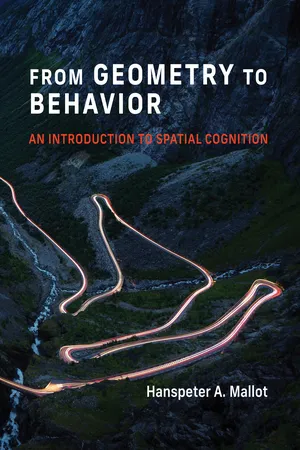
- English
- ePUB (mobile friendly)
- Available on iOS & Android
About this book
Understanding how we deal with space requires input from many fields, including ethology, neuroscience, psychology, cognitive science, linguistics, geography, and spatial information theory. In From Geometry to Behavior, cognitive neuroscientist Hanspeter A. Mallot provides an overview of the basic mechanisms of spatial behavior in animals and humans, showing how they combine to support higher-level performance. Mallot explores the biological mechanisms of dealing with space, from the perception of visual space to the constructions of large space representations: that is, the cognitive map. The volume is also relevant to the epistemology of spatial knowledge in the philosophy of mind.
Mallot aims to establish spatial cognition as a scientific field in its own right. His general approach is psychophysical, in that it focuses on quantitative descriptions of behavioral performance and their real-world determinants, thus connecting to the work of theorists in computational neuroscience, robotics, and computational geometry. After an overview of scientific thinking about space, Mallot covers spatial behavior and its underlying mechanisms in the order of increasing memory involvement. He describes the cognitive processes that underlie advanced spatial behaviors such as directed search, wayfinding, spatial planning, spatial reasoning, object building and manipulation, and communication about space. These mechanisms are part of the larger cognitive apparatus that also serves visual and object cognition; understanding events, actions, and causality; and social cognition, which includes language. Of all of these cognitive domains, spatial cognition most likely occurred first in the course of evolution and is the most widespread throughout the animal kingdom.
Frequently asked questions
- Essential is ideal for learners and professionals who enjoy exploring a wide range of subjects. Access the Essential Library with 800,000+ trusted titles and best-sellers across business, personal growth, and the humanities. Includes unlimited reading time and Standard Read Aloud voice.
- Complete: Perfect for advanced learners and researchers needing full, unrestricted access. Unlock 1.4M+ books across hundreds of subjects, including academic and specialized titles. The Complete Plan also includes advanced features like Premium Read Aloud and Research Assistant.
Please note we cannot support devices running on iOS 13 and Android 7 or earlier. Learn more about using the app.
Information
Table of contents
- Cover
- Title Page
- Copyright
- Epigraphs
- Contents
- Preface
- 1. Introduction
- 2. Egomotion
- 3. Peripersonal Space
- 4. In the Loop
- 5. Path Integration
- 6. Places and Landmarks
- 7. Spatial Memory
- 8. Maps and Graphs
- 9. Epilogue: Reason Evolves
- Index